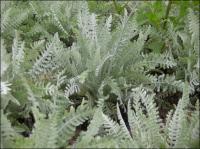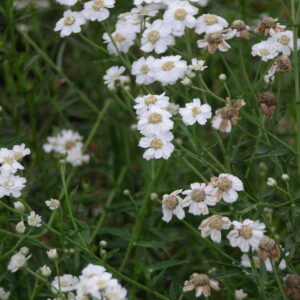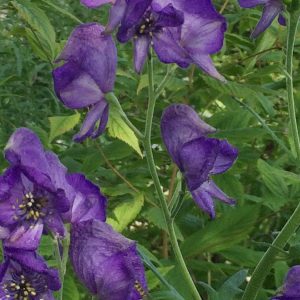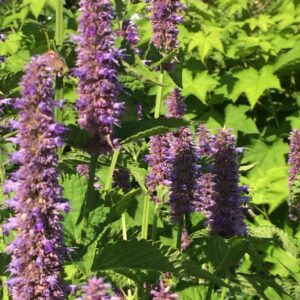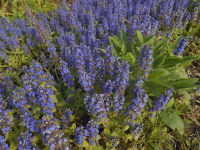Deer Resistant Plants
Showing 1–8 of 163 results
-
Acanthus spinosus Bear’s breeches Z 5-9
A WOW plant. Bodacious two-toned spikes of purple & white bracts, June to September. Glossy, deeply incised leaves. Both flowers and leaves terminate in thorny tips.
OUT OF STOCK
A WOW plant. Bodacious two-toned spikes of purple & white bracts, June to September. Glossy, deeply incised leaves. Both flowers and leaves terminate in thorny tips. One of internationally known garden designer Piet Oudolf’s 100 “MUST HAVE” plants, Gardens Illustrated 94 (2013)
LIMITED QUANTITIES AVAILABLE, LIMIT OF 1 PER CUSTOMER PLEASE.
Size: 3-4' x 2-3'
Care: Sun in well-drained soil. Be patient - slow to emerge in spring.
Native: Italy & Turkey
Wildlife Value: Attracts butterflies, Deer and rabbit resistant.The name Acanthus comes from the Greek akantha meaning “thorn” or “thistle” and spinosus means “spine” referring to the thorn on the leaf and flower tips Grown since at least 5thcentury B.C. Inspiration for Corinthian column capital in architecture of ancient Greece and Rome. According to one legend famous Athenian architect and sculptor, Callimachus, 5th century B.C. was charmed upon seeing this plant and adopted it for the top of columns he designed in Corinth. Philip Miller’s 1768 Gardener’s Dictionary, describes this as having “deeply jagged” leaves and “each segment is terminated with a sharp spine, as are also the foot-stalks of the leaves, and the empalement of the flower, which renders it troublesome to handle. . .”
-
Achillea clypeolata Yarrow Z 3-9
Mustard yellow platters in summer on fern-like, thick clumps of gorgeous, silver dissected foliage.
Mustard yellow platters in summer on fern-like, thick clumps of gorgeous, silver dissected foliage.
Size: 18" x 24"
Care: sun in well-drained to moist well-drained soil.
Native: BalkansAchillea named for Achilles, hero of Homer’s Illiad, who used Achillea millefolium to stop bleeding of his wounded soldiers. Clypeolata means “with a shield.” Described in 1813 in Fl. Graec. Prodr. 2: 193 (1813) giving credit to French botanist Joseph Tournefort (1656-1708.)
-
Achillea filipendulina Fernleaf Yarrow Z 3-10
June-July mustard yellow platters on erect stems. Good dried flowers.
June-July mustard yellow platters on erect stems. Good dried flowers.
Size: 3’-4’ x 30”
Care: Full sun in well-drained to moist-well-drained soil. Heat and drought tolerant
Native: Caucasus, Iran, Afganistan.Achillea named for Achilles, hero of Homer’s Iliad, used Achillea millefolium to stop bleeding of his wounded soldiers at the siege of Troy. Achilles learned about the uses of Achillea from Chiron, the Centaur. Introduced to gardens in 1804 when it was sent from the Caucasus to Europe.
-
Achillea ptarmica ‘The Pearl’ Sneezewort, Shirtbuttons Z 3-9
Spring - summer frilly, white “shirtbuttons”
Spring – summer frilly, white “shirtbuttons”
LIMITED QUANTITES AVAILABLE, LIMIT OF 1 PER CUSTOMER PLEASE.
Size: 12-36”x 24”
Care: Full sun, well-drained to moist well-drained soil.
Native: North temperate regionsPtarmica is Greek for sneeze because this plant used for snuff. English brides carried this at their weddings and called the plant “Seven years’ love.” Cultivated in Europe since the Middle Ages and in the U.S. since the 1700’s. The double form grown in English gardens by 1597. Philip Miller (1768) referred to this as “double Maudlin.” “The Pearl” described in the May 1905 edition of The Garden as “probably giving more satisfaction than any other white-flowered hardy perennial. The Pearl is a pearl indeed.”
-
Aconitum napellus Monkshood Wolfsbane Z 5-8 POISON
Striking, late summer to fall tall stalks, top third covered with flowers, blue washed purple each topped with a hood, in ancient times like a monks’ hood, today like a sweatshirt’s hoody.
Striking, late summer to fall on the top third of tall stalks, covered with flowers, blue washed purple each topped with a hood, in ancient times like a monks’ hood, today like a sweatshirt’s hoody.
LIMITED QUANTITIES AVAILABLE, LIMIT OF 1 PER CUSTOMER PLEASE.
Size: 2-3’x 12”
Care: part shade, cool, moist soil
Native: Europe
Wildlife Value: Aconitums are unusual. They change sex, which, in turn increases procreation! When first blooming they have a “male phase” of about 5-6 days when pollen is available, and the plant produces more nectar and stronger scent. Then the male parts wither making the pollen available to the female parts. The pollen is toxic to bees so most avoid it leaving more for the female parts, therefore increasing fertilization. However, bees are able to collect nectar without harm. https://botany.one/2019/11/aconitum-offers-bees-more-nectar-to-carry-its-toxic-pollen/ Also deer resistant.
Awards: Elisabeth Carey Miller Botanical Garden Great Plant PicksThe name Aconitum is from the mythical hill Aconitus in Pontica where Hercules fought with Cerberus. The Monkshood reputedly sprang from the jaws of Cerberus, the guard dog of the underworld. Believed to make a potion that helped witches fly. Identified by Dioscorides in De Materica Medica for medicinal use c. 70 A.D. Philip Miller in The Gardener’s Dictionary (1768) wrote that the name Aconitum comes from Greek word for dart “because the Barbarians used to daub their darts therewith.” Used by physicians in 1200’s and to poison wolves: “This Wolf’s bayne of all poisons is the most hastie poison.” Wm. Turner, 1560’s. Called Monkshood due to the shape of each flower like a monk’s hood. Introduced to the new world by John Winthrop in 1631.
-
Actaea pachypoda syn. Actaea alba White baneberry Z 3-8
Short white spike flowers in June, conspicuous white berries in fall with a black dot on showy crimson stems.
OUT OF STOCK
Short white spike flowers in June, conspicuous white berries in fall with a black dot on showy crimson stems.
Size: 36”x 18-24”
Care: part to full shade in moist well-drained soil
Native: native to eastern and central No. America; Wisconsin native.
Wildlife Value: deer resistant
Awards: England’s Royal Horticultural Society Award of Merit and Great Plant Pick Award from Elizabeth Carey Miller Botanical Garden.Actaea is Latin meaning “elder,” the leaves resembling the elder tree. Pachypoda means thick foot referring to the stalk. The common name “baneberry” chosen because the berries are poisonous. The Blackfoot boiled the roots to cure coughs and colds. In the 1800’s, used to cure “reflex uterine headache, rheumatism, congestion in the female especially, debility and gastralgia.” Sent to England before 1768, Philip Miller.
-
Agastache foeniculum Anise hyssop Z 4-8
Purplish-blue spikes from July to October, very fragrant.
Purplish-blue spikes from July to October, very fragrant.
Size: 2-3' x 12"
Care: Full sun in well-drained soil, heat and drought tolerant.
Native: North America
Wildlife Value: Skipper butterflies and Rusty patched Bumble Bees love Anise hyssop’s nectar, Deer resistant.The name Agastache is from Greek agan and stachys meaning much like an ear of wheat referring to the shape of the flower spike. Anise hyssop leaves were used by American Americans of the Missouri River region to make tea and as a sweetener in cooking. For Cheyenne it relieved chest pain due to coughing or to a dispirited heart. Listed as an aromatic herb in Bernard McMahon’s 1805 book, American Gardener’s Calendar.
-
Ajuga genevensis Geneva Bugle Z 4-9
True blue 6” spikes in spring and early summer
True blue 6” spikes in spring and early summer. Great groundcover.
Size: 6” x 12”
Care: full sun to shade in well-drained to moist well-drained soil
Native: Europe
Wildlife Value: Tolerates foot traffic. Deer and rabbit resistant.William Robinson, father of the mixed perennial garden, called this “among the best.” (1933). In gardens before 1753.


